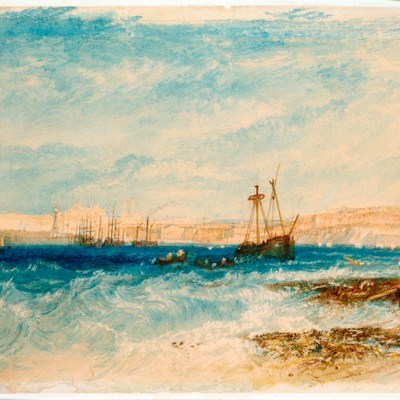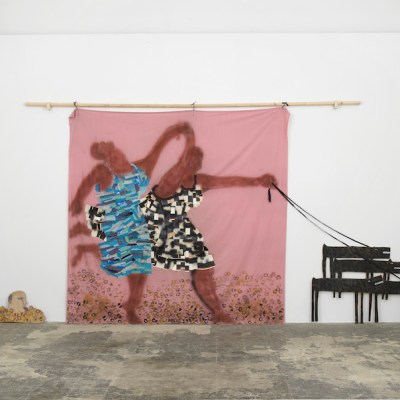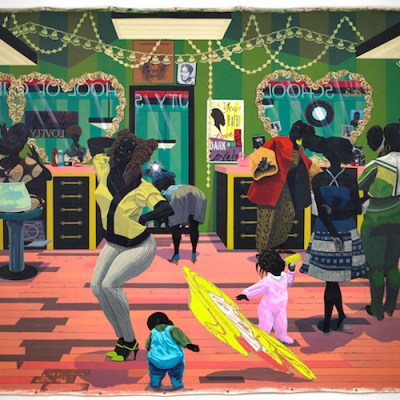The most common form of colour blindness is red-green. In one corner of Arthur Jafa’s dense exhibition of photography, video and objects at the Serpentine Gallery is LeRage (2017), a large freestanding cut-out of comic book character the Hulk angrily pulverising the ground on which he stands. The normally radioactive green figure is here rendered how a colour-blind person might see him: in a dark greyscale, suggesting that Hulk, with all his explosive fury, is a black man. Save a few clips of grainy video, most of Jafa’s installation is similarly in stark black and white, with a sense of underlying rage that is anything but colour-blind. Surrounding us with countless images of bodies – from icons like Mickey Mouse, to self-portraits and historical photographs from Jim Crow-era America – Jafa insists we notice skin colour, and acknowledge the politics of its presence and presentations.
 Visitors to the exhibition are given a pair of headphones that let you switch between three sound channels for each of the screens that make up Mix1-3_constantly evolving (2017), a trio of video collages of found and filmed imagery ranging from video games, concerts, old documentaries and YouTube footage. Jafa, an accomplished filmmaker and cinematographer who has worked with Spike Lee, Stanley Kubrick, John Akomfrah and Kara Walker, as well as Solange and Jay-Z, has only recently turned his hand to gallery-based installations. His strength here is that of arrangement, placement and juxtaposition; wandering around the gallery, each soundtrack ascribed to the three screens is unmoored, and might accompany any other part of the installation. In one instant, a loud wind howls while I look at the dyed black Confederate flag of Black Flag (2017); next, an a cappella version of ‘I Put a Spell on You’ serenades the inconsolable Hulk.
Visitors to the exhibition are given a pair of headphones that let you switch between three sound channels for each of the screens that make up Mix1-3_constantly evolving (2017), a trio of video collages of found and filmed imagery ranging from video games, concerts, old documentaries and YouTube footage. Jafa, an accomplished filmmaker and cinematographer who has worked with Spike Lee, Stanley Kubrick, John Akomfrah and Kara Walker, as well as Solange and Jay-Z, has only recently turned his hand to gallery-based installations. His strength here is that of arrangement, placement and juxtaposition; wandering around the gallery, each soundtrack ascribed to the three screens is unmoored, and might accompany any other part of the installation. In one instant, a loud wind howls while I look at the dyed black Confederate flag of Black Flag (2017); next, an a cappella version of ‘I Put a Spell on You’ serenades the inconsolable Hulk.
 Throughout the show, Jafa includes several collage works by artist Frida Orupabo, and one room almost becomes a mini exhibition of works by photographer Ming Smith. The blurred faces of Sun Ra and Amiri Baraka look out from her photos, while on my headphones a man is yelling, ‘It’s about me, not you – I’m an angry nigga!’ It’s a jumbled swell of images and sounds that sets you adrift in a composite portrait of ‘blackness’ – one that suddenly, at points, feels as if things touch, contract, and come into poignant focus.
Throughout the show, Jafa includes several collage works by artist Frida Orupabo, and one room almost becomes a mini exhibition of works by photographer Ming Smith. The blurred faces of Sun Ra and Amiri Baraka look out from her photos, while on my headphones a man is yelling, ‘It’s about me, not you – I’m an angry nigga!’ It’s a jumbled swell of images and sounds that sets you adrift in a composite portrait of ‘blackness’ – one that suddenly, at points, feels as if things touch, contract, and come into poignant focus.
Smith’s own face looks out at us from a street corner in Abhortion, 32nd and Park, New York, NY, 1978 (1978), strands of hair eclipsing her solemn face, while out of the corner of my eye, a facing wall is covered with an image of a huddled group of young, black children appearing to give what we now know as the Nazi salute. Pledge of allegiance, 1848 captures a moment in segregated Virginia before fascists in Europe took up the arm gesture, before the US Congress officially replaced the salute during the Second World War with the hand-over-the-heart still used today. Meanwhile, over all of this, I can hear from one of the videos a father playing with his kids and their stuffed animal toys: ‘I’m Bambi and I’m gonna kill yo’ ass. I’m gonna cut yo’ legs off.’ The kids scream in delight, and it is hilarious; but in this knot of simultaneous experiences is a constant violence – sorrowful yet lightly worn.

This web of ambiguous and accidental moments seem to suggest a moral imperative of how we see and are seen: that there’s an ethics to the social gaze, to communal looking. It’s a stance that feels necessary, at a moment when colonial history is being whitewashed in Brexit Britain; but also a scrutiny that, for me, shows up the Serpentine’s concurrent Grayson Perry exhibition as reductionist and filled with stereotypes. At times, Jafa leans too heavily on token references to cultural icons – whether Nina Simone, Miles Davis or George Herriman’s Krazy Kat – to stand in as symbolic recipients of a shared gaze, when it is the quieter instances that carry more weight.

For his Picture Books (1990–2005), Jafa has collected and paired hundreds of photographs and images from advertisements, fashion and music magazines. In one appears what must have been the origin of The Surge (2017), a large print covering the adjacent wall. Appearing like an inverted version of the American flag, smudged white stripes run across one side, while on the right a group of white men stand over a large fire. Yet the smaller version in the picture book holds a crucial difference: on the fire is a black body. It’s a horrific realisation, that such a fact is hidden, that the body can be made to disappear; but it’s also a reminder of what we need to look for, and what we need to face.
‘Arthur Jafa: A Series of Utterly Improbable Yet Extraordinary Renditions’ is at the Serpentine Sackler Gallery until 10 September.



